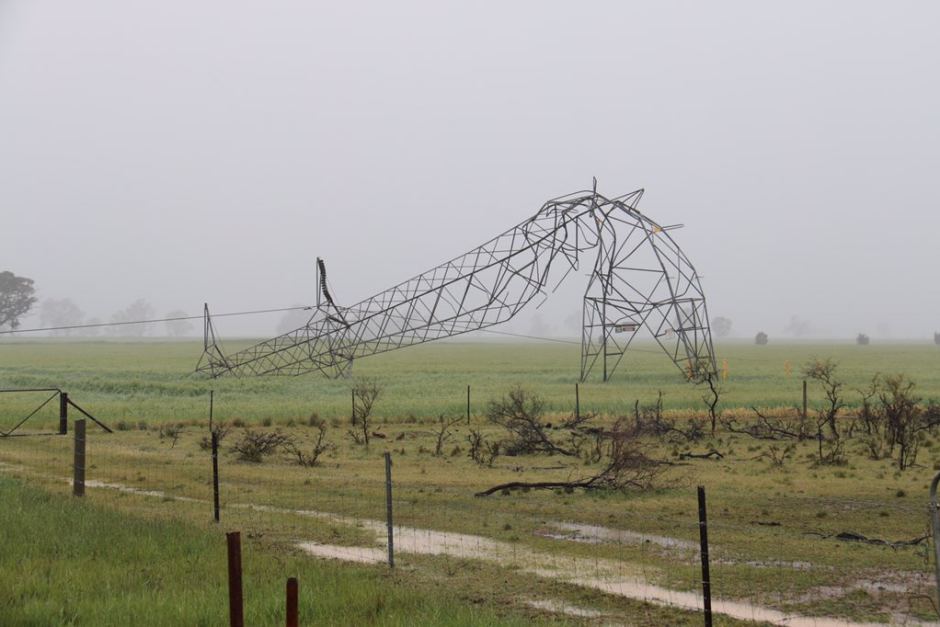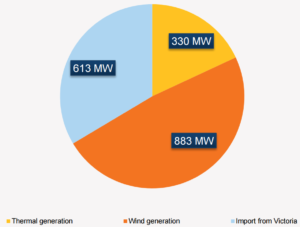On Wednesday 28 September 2016 at 4:16pm South Australia had a state wide power outage, a black start event.
I, like most people were still at work and managed to continue working for a couple of hours thanks to laptop batteries and mobile phone internet. Although riding my bike home would have been crazy given the storm and lack of traffic lights. Thankfully I got a lift home. By 11:06pm the power came back on at my place. Having the entire state’s power go out is certainly not something that happens very often, as such it begs the question as to what happened.
The short version
3 main power lines got damaged by the storm, all within less than a minute. The loss of power from them meant an increase in load from Victoria, the load was more than that connection could handle, to protect itself from overloading it disconnected. With such a sudden drop in power the remaining power generators also tripped.
The 3 main connections which were severed by the storm were 275,000 volt transmission lines. The really big ones that usually buzz. It is believed that a Tornado or at least very high wind gust caused the damage.

The more detailed explanation
It was the storm which caused the outage as it caused 3 high voltage power lines from the North of the state to be damaged with 22 towers damaged or destroyed. The 4th high voltage line also tripped, but was not directly damaged.
They all disconnected within the space of about 40 seconds. South Australia was using about 1,826MW of power at the time and without the 315MW of (wind) power from the connectors the energy needed to come from somewhere. There was increased load on the Heywood Interconnector to Victoria to compensate. This went from delivering 525MW to well over the 600MW maximum rating it was designed to transmit. As a protection measure the connection was dropped, meaning that within less than a minute (and most of it happening within a couple of seconds) the state was now 850MW-900MW short of power.
The unexpected disconnections also caused the frequency of the electricity supply to change to fast. The power in Australia aims to run at 50hz (the US has 60 cycles a second) and the frequency is allowed to change by 1 Hz/second and the power generators don’t run if it’s below 47 Hz. The loss of the link to Victoria caused the frequency to drop by 6 and 7 Hz per second, far more than is tolerable, thus the rest of the power generation, the wind generators and Torrens Island power station were all dropped and the state went black.
To restore power the electricity companies had to initiate a black start procedure. From 5:23pm Electranet went and selectively turned on the Heywood interconnector, trying to get power to Torrens Island. This was important as it’s a gas fired power station able to generate up to 1,280MW of power and thus can help offset the lost power from the disconnected power lines. unfortunately the power station needs a lot of electricity to start and attempts to do that with the backup power didn’t work and storm damage caused the secondary backup to fail. The priority was getting the power from Victoria to Torrens Island. The power station was back up and running at 9pm. Pelican Point power station was also switched on (it hadn’t been running prior to the blackout) and was generating power by 10:05pm
By midnight on Wednesday (28th), 80–90% of electricity that could be reconnected was. Unfortunately due to the power line failures the North was effectively cut off from the rest of the state and it wasn’t until 9pm on Friday (30th September) 2016, that the last remaining transmission line to the southern Eyre Peninsula, was restored.
There’s an interesting part about how the 4th line that tripped but wasn’t destroyed. Because of the damage to the lines it is practice and ElectraNet’s operating procedure to conduct a patrol before reconnecting a line when such a ground fault occurs. Unfortunately the continued rain, poor weather and high winds (with gusts up to 120Km/h) meant the helicopters were grounded. This meant some poor sods had to drive along hundreds of km’s of power lines making sure they were fine. Thankfully the 4th line was confirmed intact and reconnected around noon on Thursday. I would like to thank the people who had to put in heroic efforts to get the power restored. Thank you.

Weather
There’s an average of 16 tornadoes we know about a year in Australia and where they occurred is a known higher risk area during a time of higher activity. I’ve been told that whilst the Bureau of Meteorology can identify structures in the radar images that indicate the potential for tornadoes to develop, they can’t directly identify Tornadoes and instead rely on reports, or video from the public, emergency services and the like. Such evidence points to there being 4 tornadoes during the storm around and F1 and F2 in scale, thus it’s certainly possible there was winds up to 140Km/h that likely caused the damage to the towers.
Below is a video of a tornado forming outside Blyth on the day.
Video shows tornadoes forming outside Blyth during SA cyclone (credit: Michael Jaeschke) @abcnews @abcnewsAdelaide @ABCNews24 pic.twitter.com/wV1UZPzWTZ
— Tom Fedorowytsch (@tomfed) September 28, 2016
- https://newmatilda.com/2016/09/29/power-games-the-real-reason-south-australia-lost-electricity-supply/
- https://www.crikey.com.au/2016/09/29/south-australias-blackout-explained/
- https://changingweatherblog.wordpress.com/2016/09/30/was-this-adelaides-superstorm-sandy-moment/
- https://www.buzzfeed.com/markdistefano/powerful-toot-army – Fake Twitter Army That Trolls Renewable Energy Linked To Mining Lobby
- https://www.linkedin.com/pulse/part-23-megaproject-paradox-failure-national-market-john-noonan – This is a great article covering both the broader national energy market as well as looking at some of the black start events in more detail.
For those wanting to see a variety of stats related to electricity production check out the AER website.
Update :
There was over 200,000+ households without power on the 1st of Dec 2016 after the Heywood Interconnector dropped out the AEMO media statement mentions it was “Due to the need to balance the frequency of the network”, which further strengthens the case for Solar Thermal in Pt Augusta as such a power station would provide not just better energy security but also the Frequency Anxillary Control Services needed in this case.


Why wasn’t the Origin QPS on Torreens Island called on for the Blackstart. Leightons installed states Blackstart around 2009. 1MW diesel generator starts a 25MW gas turbine which in turn fires up a second 25MW unit then the new 125MW unit. These combined were enough to fire Torrens A
It’s my understanding I may be wrong but origin are paid a type of insurance fee for this feature they paid to install
power outages like the September event can be controlled if SA did actually make use of the power generation capability already in existence in the state such as Torrens Island and Pelican Point. The wind generated power failed as the windmills can’t handle strong winds???!!! WTF??? Get rid of these useless, unreliable and expensive toys and bring SA back into the 21st Century and allow SA to generate proper and reliable power.
Your correct Nigel, there were two backup providers who where meant to be able to power up Torrens, however one of the backup providers apparently got struck by lightning and the other wasn’t able to provide the power needed to start the first gas turbine, it only helped provide anxillary power so that the staff had the lights on there.
Paul you obviously didn’t read the post properly.
The outage wasn’t caused by the wind turbines being switched off or anything of the sort. Instead it was caused by the interconnector power lines being damaged. We had nearly half the power being generated by wind.
It’s the very gas generators you talk about which really let us down check out http://reneweconomy.com.au/south-australia-gas-generation-needed-68026/ for more infomation.
The main culprit in all of this was AEMO. A once in 50 year event and instead of battening down and configuring the network in a way which would withstand the maximum amount of failures possible they instead kept it configured with the same safety margin as normal.. If on that day AEMO had said we are forgetting about the market and chosen generators close to the city to provide power for the city then Adelaide would have not gone black. It isn’t a matter of renewables being the issue at all it is a failure of the market. I do not understand why AEMO have been held accountable for this failure. Having a different selection of power generators for a 24 hour period could have avoided much of the loss associated with this event. The failure of our own contracted black start providers is also something that should be pursued aggressively.
I notice AEMO have leveraged this blackout to get the power to switch of rooftop solar generation because “it might suddenly cause a loss of power to the grid”. If on 28/9/2016 they had turned of the generators at the end of very long vulnerable transmission lines then we would not have had a statewide blackout. I still want to know why the network wasn’t configured for maximum robustness on a day when the Bureau of Meteorology had predicted a once in a 50 year event. This question was never asked at any of the inquiries because to do so would expose the markets inadequacy as reliable source of power.